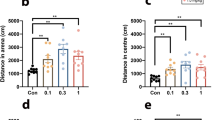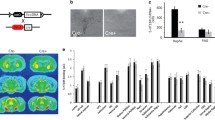Abstract
The effects of a range of 5-HT receptor antagonists were examined in an animal model of anxiety — the social interaction test. Six antagonists with high affinity for 5-HT1C receptors; mianserin, (+) mianserin, 1-naphthyl piperazine, ICI 169 369, pizotifen and LY 53857 all increased the time spent in active social interaction by pairs of weight-matched rats under high light unfamiliar conditions. As locomotion was only increased by 1-NP and then only at high doses, the effect of the drugs is consistent with anxiolysis. These properties were shared by the benzodiazepine anxiolytic chlordiazepoxide but not by the specific 5-HT2 antagonists ketanserin and altanserin, nor by the 5-HT1A and 5-HT1B antagonists cyanopindolol and pindolol. Similarly, neither the adrenergic α2 antagonist idazoxan, the α2 antagonist and putative 5-HT1D partial agonist yohimbine nor the H1 antagonist mepyramine had any significant effect. Since (+)mianserin, LY 53857 and ICI 169 369 at least have low affinity for 5-HT3 receptors these receptors are also unlikely to be involved. The results therefore imply that the observed anxiolytic effects of the drugs are likely to be mediated by 5-HT1C receptor blockade.
Similar content being viewed by others
References
Alexander BS, Wood MD (1987) Stereoselective blockade of central (3-H) 5-Hydroxytryptamine binding to multiple sites (5-HT1A, 5-HT1B and 5-HT1C) by mianserin and propranolol. J Pharm Pharmacol 39:664–666
Becker HC (1986) Comparison of the effects of the benzodiazepine midazolam and three serotonin antagonists on a consummatory conflict paradigm. Pharmacol Biochem Behav 24:1057–1064
Blackburn TP, Thornber CW, Pearce RJ, Cox B (1988) In vitro studies with ICI 169 369, a chemically novel 5-HT antagonist. Eur J Pharmacol 150:247–256
Caccia S, Ballabio M, Samanin R (1981) m-Chlorophenylpiperazine, a central 5-hydroxytryptamine agonist, is a metabolite of trazodone. J Pharm Pharmacol 34:477–478
Ceulemans DLS, Hoppenbrouwers MLJA, Gelders YG, Reyntjens AJM (1985) The influence of ritanserin, a serotonin antagonist, in anxiety disorders: a double-blind placebo-controlled study versus lorazepam. Pharmacopsychiatry 18:303–305
Charney DS, Woods SW, Goodman WK, Heninger GR (1987) Serotonin function in anxiety. II. Effects of the serotonin agonist mCPP in panic disorder patients and healthy patients. Psychopharmacology 92:14–21
Clineschmidt BV, Flataker LM, Faison E, Holmes R (1979) An in vivo model for investigating α1 and α2-receptors in the CNS: studies with mianserin. Arch Int Pharmacodyn 242:59–76
Cohen ML, Fuller RW, Kurz KD (1983) LY 53857, a selective and potent serotonergic (5-HT2) receptor antagonist, does not lower blood pressure in the spontaneous hypertensive rat. J Pharmacol Exp Ther 227:327–332
Colpaert FC, Meert TF, Niemegeers CJE, Janssen PAJ (1985) Behavioural and 5-HT antagonist effects of ritanserin: a pure and selective antagonist of LSD discrimination in the rat. Psychopharmacology 86:45–54
Conn PJ, Sanders-Bush E (1987) Relative efficacies of piperazines at the phosphoinositide hydrolysis-linked serotonergic (5-HT2 and 5-HT1C) receptors. J Pharmacol Exp Ther 242:552–557
Conti L, Pinder RM (1979) A controlled comparative trial of mian-serin and diazepam in the treatment of anxiety states in psychiatric outpatients. J Int Med Res 7:285–289
Cook L, Sepinwall J (1975) Behavioural analysis of the effects and mechanisms of action of benzodiazepines. In: Costa E, Greengard P (eds) Mechanisms of action of benzodiazepines. Raven Press, New York, pp 1–28
Costall B, Domeney AM, Gerrard PA, Kelly ME, Naylor RJ (1988) Zacopride: anxiolytic profile in rodent and primate models of anxiety. J Pharm Pharmacol 40:302–305
Deacon R, Gardner CF (1986) Benzodiazepine and 5-HT ligands in a rat conflict test. Br J Pharmacol 88:330P
File SE (1981) Behavioural effects of serotonin depletion. In: Clifford Rose E (ed) Metabolic disorders of the nervous system. Pitmans, London, pp 429–445
File SE (1985) Animal models for predicting clinical efficacy of anxiolytic drugs: social behaviour. Neuropsychobiology 13:55–62
Gadie B, Lane AC, McCarthy PS, Tulloch IF, Walter DS (1983) 2-Alkyl analogues of RX 781094: potent selctive antagonists at central α2-adrenoceptors. Br J Pharmacol 78:312P
Gardner CR (1986) Recent developments in 5-HT-related pharmacology of of animal models of anxiety. Pharmacol Biochem Behav 24:1479–1485
Gleeson S, Ahlers ST, Mansbach RS, Foust JM, Barrett JE (1989) Behavioural studies with anxiolytic drugs. VI. Effects on punished responding of drugs interacting with serotonin receptor subtypes. J Pharmacol Exp Ther 250:809–817
Glennon RA, El-Kader A, Ismaiel M, McCarthy BG, Peroutka SJ (1989) Binding of arylpiperazines to 5-HT3 serotonin receptors: results of a structure-affinity study. Eur J Pharmacol 168:387–392
Graeff FG (1974) Tryptamine antagonists and punished behaviour. J Pharmacol Exp Ther 189:344–350
Graeff FG, Zuarde AW, Giglio JS, Lima Filho EC, Karniol IG (1985) Effect of metergoline on human anxiety. Psychopharmacology 86:334–338
Guy AP, Gardner CR (1985) Pharmacological characterization of a modified social interaction model of anxiety in the rat. Neuropsychobiology 13:194–201
Hoyer D (1989) 5-Hydroxytryptamine receptors and effector coupling mechanisms in peripheral tissues. In: Fozard J (ed) Peripheral actions of 5-HT. Oxford University Press, Oxford, pp 72–99
Hoyer D (1990) Competitive antagonism by recognised 5-HT2 receptor antagonists at 5-HT1C receptors. Naunyn Schmiedeberg's Arch Pharmacol 341:Suppl R88
Hoyer D, Pazos A, Probst A, Palacios JM (1986) Serotonin receptors in the human brain. 1. Characterization and autoradiographic localization of 5-HT1A recognition sites. Apparent absence of 5-HT1B recognition sites. Brain Res 376:85–96
Jones BJ, Costall B, Domeney AM, Kelly ME, Naylor RJ, Oakley NR, Tyers MB (1988) The potential anxiolytic activity of GR 38032F, a 5-HT3-receptor antagonist. Br J Pharmacol 93:985–993
Kahn RS, Van Praag HM, Wetzler S, Asnis GM, Barr G (1988) Serotonin and anxiety revisited. Biol Psychiatry 23:189–208
Kahn RS, Wetzler S, Asnis GM, Kling MA, Suckow RF, Van Praag HM (1990) Effects of m-chlorophenylpiperazine in normal subjects: a dose-response study. Psychopharmacology 100:339–344
Kennett GA, Curzon G (1988a) Evidence that mCPP may have behavioural effects mediated by 5-HT1C receptors. Br J Pharmacol 94:137–147
Kennett GA, Curzon G (1988b) Evidence that hypophagia induced by mCPP and TFMPP requires 5-HT1C and 5-HT1B receptors; hypophagia by RU 24969 only requires 5-HT1B receptors. Psychopharmacology 96:93–100
Kennett GA, Blackburn TP (1990) Anxiolytic-like actions of BRL 46470A — a novel 5-HT3 receptor antagonist. J Psychopharmacology 4:4
Kennett GA, Curzon (1991) Potencies of antagonists indicate that 5-HT1C receptors mediate 1–3(chlorophenyl) piperazine-induced hypophagia. Br J Pharmacol 103:2016–2020
Kennett GA, Dourish CT, Curzon G (1987) 5-HT1B agonists induce anorexia at a postsynaptic site. Eur J Pharmacol 141:137–147
Kennett GA, Whitton P, Shah K, Curzon G (1989) Anxiogenic-like effects of mCPP and TFMPP in animal models are opposed by 5-HT1C receptor antagonists. Eur J Pharmacol 164:445–454
Kennett GA, Whitton P, Curzon G (1990) ID50 values of antagonists vs mCPP-induced hypophagia and 5-HT2-mediated headshakes indicate that 5-HT1C sites mediate the hypophagia. Br J Pharmacol 99:241P
Khan MC, Bennie EH, Stulemeijer SM, Ravens MA (1983) Mianserin and doxepin in the treatment of outpatient depression with anxiety. Br J Clin Pharmacol 15:213S-218S
Kilpatrick GJ, Jones BJ, Tyers MB (1988) Identification and distribution of 5-HT3 receptors in rat brain using radioligand binding. Nature 330:746–749
Leone CML, De Aguir JC, Graeff FG (1983) Role of 5-hydroxytryptamine in amphetamine effects on punished and unpunished behaviour. Psychopharmacology 80:78–82
Leysen JE, Awouters F, Kennis L, Laduron PM, Vandenberk J, Janssen PAJ (1981) Receptor binding profile of R41 468, a novel antagonist of 5-HT2 receptors. Life Sci 28:1015–1022
Martin LL, Sanders-Bush E (1982) Comparison of the pharmacological characteristics of 5-HT1 and 5-HT2 binding sites with those of serotonin autoreceptors which modulate serotonin release. Naunyn-Schmiedeberg's Arch Pharmacol 321:165–170
Mason P, Skinner J, Luttinger D (1987) Two tests in rats for antianxiety effect of clinically anxiety attenuating antidepressants. Psychopharmacology 92:30–33
Mueller EA, Murphy DL, Sunderland T (1985) Neuroendocrine effects of m-chlorophenylpiperazine, a serotonin agonist in humans. J Clin Endocrinol Metab 61:1179–1184
Murphy JE (1978) Mianserin in the treatment of depressive illness and anxiety states in general practice. Br J Clin Pharmacol 5:81S-85S
Nelson DR, Thomas DR (1989) (3-H)-BRL 43694 (Granisetron), a specific ligand for 5-HT3 binding sites in rat brain cortical membranes. Biochem Pharmacol 10:1693–1695
Nicholson VS, Wieringa JH, Van Delft AML (1982) Comparative pharmacology of mianserin, its main metabolites and 6-azamianserin. Naunyn-Schmiedeberg's Arch Pharmacol 319:48–55
Niesink RJM, Van Ree JM (1982) Antidepressant drugs normalise the increased social behaviour of pairs of male rats induced by short term isolation. Neuropharmacology 21:1343–1348
Pigott TA, Zohar J, Hill JL, Bernstein SE, Grover GN, Zohar-Kadouch RC, Murphy DL (1990) Metergoline blocks the behavioural and neuroendocrine effects of orally administered mCPP in obsessive-compulsive disorder. Biol Psychiatry 29:418–426
Piper D, Upton N, Thomas DL, Nicholass J (1988) The effects of 5-HT3 receptor antagonists BRL 43694 and GR 38032F in animal models of anxiety. Br J Pharmacol 94:314P
Russell GFM, Niaz U, Wakeling A, Slade PD (1978) Comparative double-blind trial of mianserin hydrochloride (Organon GB94) and diazepam in patients with depressive illness. Br J Clin Pharmacol 5:57S-65S
Schoeffter P, Hoyer D (1989a) Interaction of arylpiperazines with 5-HT1A, 5-HT1B, 5-HT1C and 5-HT1D receptors: do discriminatory 5-HT1B receptor ligands exist? Naunyn-Schmiedeberg's Arch Pharmacol 339:675–682
Schoeffter P, Hoyer D (1989b) 5-Hydroxytryptamine 5-HT1B and 5-HT1D receptors mediating inhibition of adenylate cyclase activity. Pharmacological comparison with special reference to the effects of yohimbine, rauwolscine and some β-adrenoceptor antagonists. Naunyn-Schmiedeberg's Arch Pharmacol 340:285–292
Seibyl JP, Krystal JH, Price LH, Woods SW, Heninger GR, Charney DS (1989) 5-HT function in the biochemical and behavioural responses to mCPP in healthy subjects and schizophrenics. Am Soc Neurosci Abstr 15:485.21
Sepinwall J, Cook L (1980) Mechanism of action of the benzodiazepines: Behavioral aspect. Fed Proc 39:3024–3031
Sills MA, Wolfe BB, Frazer A (1984) Determination of selective and non-selective compounds for the 5-HT1A and 5-HT1B receptor subtypes in rat frontal cortex. J Pharmacol Exp Ther 231:480–487
Stein L, Wise CD, Belluzzi JD (1975) Effects of benzodiazepines on central serotonergic mechanisms. In: Costa E, Greengard P (eds) Mechanism of action of benzodiazepines. Raven Press, New York, pp 29–44
Tricklebank MD, Forler C, Fozard J (1984) The involvement of subtypes of the 5-HT1A receptor and of catecholaminergic systems in the behavioural response to 8-Hydroxy-2-(di-n-propylamino)tetralin in the rat. Eur J Pharmacol 106:271–277
Whitton P, Curzon G (1990) Anxiogenic-like effect of infusing 1-(3-chlorophenyl)piperazine (mCPP) into the hippocampus. Psychopharmacology 100:138–140
Winter JD (1972) Comparison of chlordiazepoxide, methysergide and cinanserin as modifiers of punished behaviour and as antagonists of N,N-dimethyltryptamine. Arch Int Pharmacodyn Ther 197:147–159
Zohar J, Insel TR (1987) Obsessive-compulsive disorder: psychobiological approaches to diagnosis, treatment and pathophysiology. Biol Psychiatry 22:667–687
Zohar J, Mueller EA, Insel TR, Zohar-Kadouch RC, Murphy DL (1987) Serotonergic responsivity in obsessive compulsive disorder: comparison of patients and healthy controls. Arch Gen Psychiatry 45:167–172
Author information
Authors and Affiliations
Rights and permissions
About this article
Cite this article
Kennett, G.A. 5-HT1C receptor antagonists have anxiolytic-like actions in the rat social interaction model. Psychopharmacology 107, 379–384 (1992). https://doi.org/10.1007/BF02245165
Received:
Revised:
Issue Date:
DOI: https://doi.org/10.1007/BF02245165




